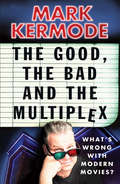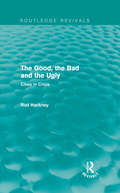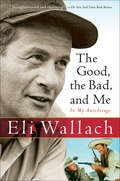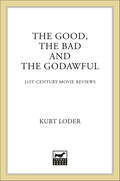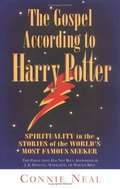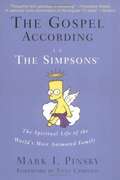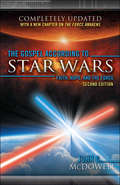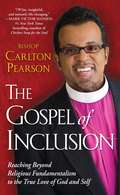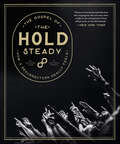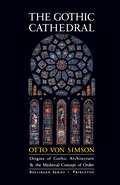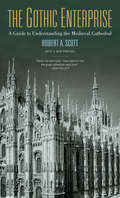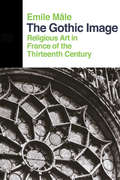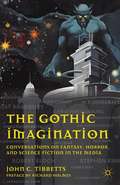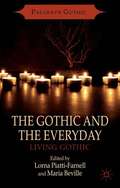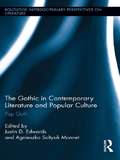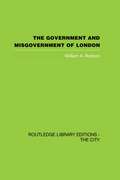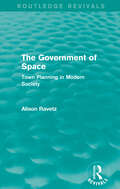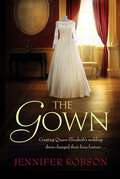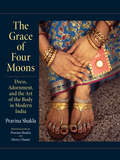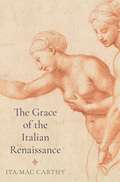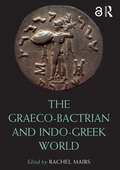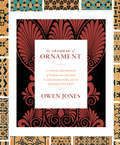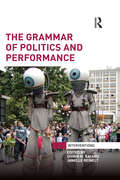- Table View
- List View
The Good Place (TV Milestones Series)
by Erin Giannini"Pobody’s nerfect" - or whatever the saying might be! As humans we are constantly worried about how our actions may come back to haunt us. The Good Place (2016–2020) is a high-concept American sitcom that brought light to the dark topic of the afterlife, and the show tackled this worry head-on. Although it had a lifespan of only four seasons, The Good Place made a lasting impact on American television culture and garnered many accolades for producer Michael Schur (also producer of The Office, Parks and Recreation, and Brooklyn Nine-Nine). Author Erin Giannini argues that the show redefines the classic sitcom structure by mixing the genres of fantasy and comedy, while simultaneously teaching the viewers the importance of character development through the analysis of moral and ethical principles. Giannini also analyzes the "not so in your face" political commentary seen in The Good Place, as this show took place during a tumultuous time in American politics. Television studies scholars and fans of the show will enjoy Giannini’s analysis of The Good Place as they read about the show’s laughs and twists and turns.
The Good, The Bad and The Multiplex
by Mark KermodeIf blockbusters make money no matter how bad they are, then why not make a good one for a change?How can 3-D be the future of cinema when it's been giving audiences a headache for over a hundred years? Why pay to watch films in cinemas that don't have a projectionist but do have a fast-food stand? And, in a world where Sex and the City 2 was a hit, what are film critics even for? Outspoken, opinionated and hilariously funny, The Good, The Bad and The Multiplex is a must for anyone who has ever sat in an undermanned, overpriced cinema and wondered: 'How the hell did things get to be this terrible?'
The Good, the Bad and the Ugly (Routledge Revivals)
by Rod HackneyFirst published in 1990, this title presents the personal reflections of renowned community architect Rod Hackney, who served for many years as President of both the Royal Institute of British Architects and the International Union of Architects. Educated in the Modernist tradition of architecture in Britain and Denmark, Hackney’s return to England in the 1970s changed his outlook completely. Cities like Birmingham and Sheffield had been ruined by ill-conceived planning; whole communities had been torn apart by massive destruction of Victorian terraces, and relocated to grim tower block estates. To those communities that he has rescued from the threat of redevelopment, Rod Hackney is a local hero. Determined to save Britain’s inner cities, he has been a major influence on Prince Charles and a powerful spokesman for the silent majority of the urban poor, who often have no say as to where and how they live.
The Good, the Bad, and Me: In My Anecdotage
by Eli Wallach“A simply written, effective tale of an ambitious and hard-working American actor trying to make his dream come true.” —Los Angeles TimesThe sparkling memoir of a movie icon’s life in the footlights and on camera, The Good, the Bad, and Me tells the extraordinary story of Eli Wallach’s many years dedicated to his craft. Beginning with his early days in Brooklyn and his college years in Texas, where he dreamed of becoming an actor, this book follows his career as one of the earliest members of the famed Actors Studio and as a Tony Award winner for his work on Broadway. Wallach worked with such stars as Marlon Brando, Paul Newman, Marilyn Monroe, Gregory Peck, and Henry Fonda, and his many movies included The Magnificent Seven, How the West Was Won, the iconic The Good, the Bad and the Ugly, and Mystic River. For more than fifty years Eli Wallach held a special place in film and theater, and in a tale rich with anecdotes, wit, and remarkable insight he recounted his magical life in a world unlike any other.“Mr. Wallach’s writing is just like his acting: pure, deceptively simple, and honest, and with not a little humor. He has a sharp eye and tells some wickedly funny and touching stories . . . A great read!” —Liam Neeson “[Wallach is] an excellent tour guide through his life, from Red Hook to the Army to Broadway and the big and small screens . . . He comes across as a man who’s had a helluva lot of fun entertaining us.” —Variety
The Good, the Bad, and the Godawful: 21st-Century Movie Reviews
by Kurt LoderThe former Rolling Stone writer and MTV host takes off from classic Roger Ebert and sails boldly into the new millennium.Millions grew up reading the author's record reviews and watching him on MTV's "The Week in Rock." In this collection of more than 200 movie reviews from MTV.com and, more recently, the Reason magazine Website, plus sidebars exclusive to this volume, Loder demonstrates his characteristic wry voice and finely honed observations. The author shines when writing on the best that Hollywood and indie filmmakers have to offer, and his negative reviews are sometimes more fun than his raves. This freewheeling survey of the wild, the wonderful and the altogether otherwise is an indispensable book for any film buff.
The Gospel According to Harry Potter: Spirituality in the Stories of the World's Most Famous Seeker
by Connie Nealfrom a Review of "The Gospel According to Harry Potter by Connie Neal" by Jonathan Marlowe, pastor of Shiloh United Methodist Church in Granit Quarry, NC Connie Neal goes carefully through the four Harry Potter books that have been published so far, and patiently shows us the same kind of "points of contact" with the Bible that I discussed with the children in my church. These "points of contact" (or "glimmers of the gospel," as she calls them) include how Lily Potter's sacrifice for the sake of her son Harry corresponds to Christ's sacrifice for us on the cross, how Dumbledore's deep wisdom mirrors the character of God, and how evil forces operate through deception and violence. Neal is careful not to treat the Potter series as Christian allegory, acknowledging that the Potter stories are different from C.S. Lewis' Chronicles of Narnia. But she wants to prove that J. K. Rowling was right when she said, "You can find in these stories whatever you are looking for." So many have found evidence of witchcraft and the occult in these stories because that is what they were seeking. But Neal has gone to the same stories looking instead for the gospel, and much to the reader's delight, she has found it.
The Gospel According to The Simpsons: The Spiritual Life of the World's Most Animated Family
by Mark I. PinskyReligion journalist Pinksy looks at the role religion and spirituality plays in The Simpsons.
The Gospel according to Star Wars: Faith, Hope, And The Force
by John C. McDowellIn a new and updated version of this best-selling book, John McDowell explores the many spiritual themes that weave throughout the Star Wars films. From the Force to the dark side, the issues discussed in the films have a moral and spiritual complexity that, if paid attention to, can help us better understand our place in the world and our relation to others and to God. George Lucas, the creator of Star Wars, did not intend for his films to be mere entertainment, McDowell argues. Rather, he hoped his films would be used as a vehicle for moral education. <P><P>This new version has been thoroughly revised to include discussion of The Force Awakens and other new developments in the Star Wars universe.
The Gospel of Inclusion: Reaching Beyond Religious Fundamentalism to the True Love of God and Self
by Carlton PearsonFourth-generation fundamentalist Carlton Pearson, a Christian megastar and host, takes a courageous and controversial stand on religion that proposes a hell-less Christianity and a gospel of inclusion that calls for an end to local and worldwide conflicts and divisions along religious lines.In The Gospel of Inclusion, Bishop Carlton Pearson explores the exclusionary doctrines in mainstream religion and concludes that, according to the evidence of the Bible and irrefutable logic, they cannot be true. Bishop Pearson argues that the controlling dogmas of religion are the source of much of the world's ills and that we should turn our backs on proselytizing and holy wars and focus on the real good news: that we are all bound for glory, everybody is saved, and if we believe God loves all mankind, then we have no choice but to have the same attitude ourselves. Bishop Pearson tells the story of how he had gone from a powerful religious figure, once preaching to an audience of over 6,000 people, to watching everything he had built crumble around him due to a scandal. Why? He didn't steal money nor did he have inappropriate sexual relationships. Following a revelation from God, he began to preach that a loving God would not condemn most of the human race to hell because they are not Christian. He preaches that God belongs to no religion. The Gospel of Inclusion is the inspiring journey of one man's quest to preach a new truth.
The Gospel of the Hold Steady: How a Resurrection Really Feels
by Michael Hann The Hold SteadyAn oral history (with photographs) of the greatest American bar band of the twenty-first century."Plenty of rock bands treat their fans like congregants. But, not many shine a light on the arrangement. Fewer still go as far as The Hold Steady, whose lead vocalist and lyricist, Craig Finn, has a disarming way of combining humility and exultation." —New York TimesOn January 22, 2003, four men stepped onto a stage in Brooklyn and did something no one else was doing at that time, in that place. They played rock ’n’ roll: old-fashioned rock ’n’ roll with skyscraping riffs and sloppy solos, topped with extraordinary lyrics about an out-of-focus America, blurred by pills and powders, of crime and fear and desperation and redemption.Twenty years later, The Hold Steady are one of America’s most beloved rock bands, famed for live shows that turn unbelievers into converts, and for a catalog filled with some of the most exciting yet poetic music of the twenty-first century. To mark those twenty years, The Hold Steady tell their full story in The Gospel of The Hold Steady: How a Resurrection Really Feels. An oral history, based on interviews with everyone who has played in the band, and those who have worked with them over the course of their career, The Gospel of the Hold Steady addresses all the triumphs and setbacks of The Hold Steady’s career in the band’s own words—from high times to near deaths, from the brink of splitting to their current renaissance. The volume also includes over 200 photographs and images.The Gospel of The Hold Steady is completed by essays about America’s greatest bar band by writers Rob Sheffield, Laura Barton, Isaac Fitzgerald, and Michael Hann, as well as the thoughts and memories of “The Unified Scene”—the fans who have helped define the band’s identity over the years. This is a book for everyone who loves The Hold Steady, and anyone who understands that the magic of rock ’n’ roll happens on a stage in a small room, with voices raised from the crowd.
The Gothic Cathedral: Origins of Gothic Architecture and the Medieval Concept of Order - Expanded Edition (Bollingen Series (General) #640)
by Otto Georg Von SimsonThe description for this book, The Gothic Cathedral: Origins of Gothic Architecture and the Medieval Concept of Order, will be forthcoming.
The Gothic Enterprise: A Guide to Understanding the Medieval Cathedral
by Robert A. ScottThe great Gothic cathedrals of Europe are among the most astonishing achievements of Western culture. Evoking feelings of awe and humility, they make us want to understand what inspired the people who had the audacity to build them. This engrossing book surveys an era that has fired the historical imagination for centuries. In it Robert A. Scott explores why medieval people built Gothic cathedrals, how they built them, what conception of the divine lay behind their creation, and how religious and secular leaders used cathedrals for social and political purposes. As a traveler's companion or a rich source of knowledge for the armchair enthusiast, The Gothic Enterprise helps us understand how ordinary people managed such tremendous feats of physical and creative energy at a time when technology was rudimentary, famine and disease were rampant, the climate was often harsh, and communal life was unstable and incessantly violent. While most books about Gothic cathedrals focus on a particular building or on the cathedrals of a specific region, The Gothic Enterprise considers the idea of the cathedral as a humanly created space. Scott discusses why an impoverished people would commit so many social and personal resources to building something so physically stupendous and what this says about their ideas of the sacred, especially the vital role they ascribed to the divine as a protector against the dangers of everyday life. Scott's narrative offers a wealth of fascinating details concerning daily life during medieval times. The author describes the difficulties master-builders faced in scheduling construction that wouldn't be completed during their own lifetimes, how they managed without adequate numeric systems or paper on which to make detailed drawings, and how climate, natural disasters, wars, variations in the hours of daylight throughout the year, and the celebration of holy days affected the pace and timing of work. Scott also explains such things as the role of relics, the quarrying and transporting of stone, and the incessant conflict cathedral-building projects caused within their communities. Finally, by drawing comparisons between Gothic cathedrals and other monumental building projects, such as Stonehenge, Scott expands our understanding of the human impulses that shape our landscape.
The Gothic Enterprise: A Guide to Understanding the Medieval Cathedral
by Robert A. ScottThe great Gothic cathedrals of Europe are among the most astonishing achievements of Western culture. Evoking feelings of awe and humility, they make us want to understand what inspired the people who had the audacity to build them. This engrossing book surveys an era that has fired the historical imagination for centuries. In it Robert A. Scott explores why medieval people built Gothic cathedrals, how they built them, what conception of the divine lay behind their creation, and how religious and secular leaders used cathedrals for social and political purposes. As a traveler’s companion or a rich source of knowledge for the armchair enthusiast, The Gothic Enterprise helps us understand how ordinary people managed such tremendous feats of physical and creative energy at a time when technology was rudimentary, famine and disease were rampant, the climate was often harsh, and communal life was unstable and incessantly violent.While most books about Gothic cathedrals focus on a particular building or on the cathedrals of a specific region, The Gothic Enterprise considers the idea of the cathedral as a humanly created space. Scott discusses why an impoverished people would commit so many social and personal resources to building something so physically stupendous and what this says about their ideas of the sacred, especially the vital role they ascribed to the divine as a protector against the dangers of everyday life.Scott’s narrative offers a wealth of fascinating details concerning daily life during medieval times. The author describes the difficulties master-builders faced in scheduling construction that wouldn’t be completed during their own lifetimes, how they managed without adequate numeric systems or paper on which to make detailed drawings, and how climate, natural disasters, wars, variations in the hours of daylight throughout the year, and the celebration of holy days affected the pace and timing of work. Scott also explains such things as the role of relics, the quarrying and transporting of stone, and the incessant conflict cathedral-building projects caused within their communities. Finally, by drawing comparisons between Gothic cathedrals and other monumental building projects, such as Stonehenge, Scott expands our understanding of the human impulses that shape our landscape.
The Gothic Image: Religious Art In France Of The Thirteenth Century
by Emile MaleEmile Male's book aids understanding of medieval art and medieval symbolism, and of the vision of the world which presided over the building of the French cathedrals. It looks at French religious art in the Middle Ages, its forms, and especially the Eastern sources of sculptural iconography used in the cathedrals of France. Fully illustrated with many footnotes it acts as a useful guide for the student of Western culture.
The Gothic Imagination
by John C. TibbettsThis book brings together the author's interviews with many prominent figures in fantasy, horror, and science fiction to examine the traditions and extensions of the gothic mode of storytelling over the last 200 years and its contemporary influence on film and media.
The Gothic and the Everyday: Living Gothic (The Palgrave Gothic Series)
by Gill PartingtonThe Gothic and the Everyday aims to regenerate interest in the Gothic within the experiential contexts of history, folklore, and tradition. By using the term 'living', this book recalls a collection of experiences that constructs the everyday in its social, cultural, and imaginary incarnations
The Gothic in Contemporary Literature and Popular Culture: Pop Goth (Routledge Interdisciplinary Perspectives on Literature)
by Justin D. Edwards Agnieszka Soltysik MonnetThis interdisciplinary collection brings together world leaders in Gothic Studies, offering dynamic new readings on popular Gothic cultural productions from the last decade. Topics covered include, but are not limited to: contemporary High Street Goth/ic fashion, Gothic performance and art festivals, Gothic popular fiction from Twilight to Shadow of the Wind, Goth/ic popular music, Goth/ic on TV and film, new trends like Steampunk, well-known icons Batman and Lady Gaga, and theorizations of popular Gothic monsters (from zombies and vampires to werewolves and ghosts) in an age of terror/ism.
The Government and Misgovernment of London
by William A. RobsonThis book was first published in 1939.
The Government of Space: Town Planning in Modern Society (Routledge Revivals)
by Alison RavetzBritain’s planning system began as ‘town and country planning’ to repair the ravages of unplanned industrialism and promote ideal environments for the future. Steering a course between left and right, public control and for-profit development, it survived successive booms and busts, broadening to include new concerns like ecology, conservation and community participation. By the 1986, when this book was first published, the system’s survival beyond the year 2000 was in doubt. It did endure, but it is now under serious threat from the right, which sees it as obstructing enterprise and the restoration of ‘growth’. It has been stripped of some of its core aims and mechanisms, while as yet there is no agenda distinguishing growth that will be sustainable from growth which self-evidently is not. The Government of Space was written as a concise guide for the non-specialist to the origins and evolution of British planning, its intellectual pedigree, achievements and cruxes. It is an invaluable background to the state of planning and the cases for and against it today.
The Gown: Perfect for fans of The Crown! An enthralling tale of making the Queen's wedding dress
by Jennifer RobsonPerfect for anyone who's captivated by The Crown, The Gown 'will dazzle and delight' (Independent)!The Gown is an enthralling historical novel about one of the most famous wedding dresses of the twentieth century - Queen Elizabeth's wedding gown - and the fascinating women who made it. London, 1947: Besieged by a harsh winter, burdened by shortages and rationing, the people of post-war Britain are suffering despite their nation's recent victory. For Ann Hughes and Miriam Dassin, embroiderers at the famed Mayfair fashion house of Norman Hartnell, a glimmer of brightness comes in the form of their unlikely friendship and being chosen for a once-in-a-lifetime honour: taking part in the creation of Princess Elizabeth's wedding gown. Toronto, 2016: Heather Mackenzie seeks to unravel the mystery of a legacy from her late grandmother. How did her beloved nan, who never spoke of her old life in Britain, come to possess the priceless embroideries that so closely resemble the motifs on the stunning gown worn by Queen Elizabeth II at her wedding almost seventy years before? And what was her nan's connection to the celebrated textile artist and Holocaust survivor Miriam Dassin?With The Gown, Jennifer Robson takes us inside the workrooms where one of the most famous wedding gowns in history was created to tell a story of women whose lives are woven together by the pain of survival, the bonds of friendship, and the redemptive power of love.'Robson succeeds in creating a riveting drama of female friendship, of lives fully lived despite unbearable loss, and of the steadfast effort required to bring forth beauty after surviving war' Independent'A great tale of female friendship' The People's Friend
The Grace of Four Moons
by Pravina ShuklaBecause clothing, food, and shelter are basic human needs, they provide excellent entries to cultural values and individual aesthetics. Everyone gets dressed every day, but body art has not received the attention it deserves as the most common and universal of material expressions of culture. The Grace of Four Moons aims to document the clothing decisions made by ordinary people in their everyday lives. Based on fieldwork conducted primarily in the city of Banaras, India, Pravina Shukla conceptualizes and realizes a total model for the study of body art--understood as all aesthetic modifications and supplementations to the body. Shukla urges the study of the entire process of body art, from the assembly of raw materials and the manufacture of objects, through their sale and the interactions between merchants and consumers, to the consumer's use of objects in creating personal decoration.
The Grace of the Italian Renaissance
by Ita Mac CarthyHow grace shaped the Renaissance in Italy"Grace" emerges as a keyword in the culture and society of sixteenth-century Italy. The Grace of the Italian Renaissance explores how it conveys and connects the most pressing ethical, social and aesthetic concerns of an age concerned with the reactivation of ancient ideas in a changing world. The book reassesses artists such as Francesco del Cossa, Raphael and Michelangelo and explores anew writers like Castiglione, Ariosto, Tullia d'Aragona and Vittoria Colonna. It shows how these artists and writers put grace at the heart of their work.Grace, Ita Mac Carthy argues, came to be as contested as it was prized across a range of Renaissance Italian contexts. It characterised emerging styles in literature and the visual arts, shaped ideas about how best to behave at court and sparked controversy about social harmony and human salvation. For all these reasons, grace abounded in the Italian Renaissance, yet it remained hard to define. Mac Carthy explores what grace meant to theologians, artists, writers and philosophers, showing how it influenced their thinking about themselves, each other and the world.Ambitiously conceived and elegantly written, this book portrays grace not as a stable formula of expression but as a web of interventions in culture and society.
The Graeco-Bactrian and Indo-Greek World (Routledge Worlds)
by Rachel MairsThis volume provides a thorough conspectus of the field of Graeco-Bactrian and Indo-Greek studies, mixing theoretical and historical surveys with critical and thought-provoking case studies in archaeology, history, literature and art. The chapters from this international group of experts showcase innovative methodologies, such as archaeological GIS, as well as providing accessible explanations of specialist techniques such as die studies of coins, and important theoretical perspectives, including postcolonial approaches to the Greeks in India. Chapters cover the region’s archaeology, written and numismatic sources, and a history of scholarship of the subject, as well as culture, identity and interactions with neighbouring empires, including India and China. The Graeco-Bactrian and Indo-Greek World is the go-to reference work on the field, and fulfils a serious need for an accessible, but also thorough and critically-informed, volume on the Graeco-Bactrian and Indo-Greek kingdoms. It provides an invaluable resource for anyone interested in the Hellenistic East. The Introduction and Chapter 17 of this book is freely available as a downloadable Open Access PDF at http://www.taylorfrancis.com under a Creative Commons Attribution-Non Commercial-No Derivatives (CC-BY-NC-ND) 4.0 license
The Grammar of Ornament: A Visual Reference of Form and Colour in Architecture and the Decorative Arts
by Owen JonesThe complete and unabridged full-color editionFirst published in 1856, The Grammar of Ornament remains a design classic. Its inspiration came from pioneering British architect and designer Owen Jones (1809-1874), who produced a comprehensive design treatise for the machine age, lavishly illustrated in vivid chromolithographic color. Jones made detailed observations of decorative arts on his travels in Europe, the Middle East, and in his native London, where he studied objects on display at the Great Exhibition of the Works of Industry of All Nations in 1851 and at local museums. His aim was to improve the quality of Western design by changing the habits of Victorian designers, who indiscriminately mixed elements from a wide variety of sources.Jones's resulting study is a comprehensive analysis of styles of ornamental design, presenting key examples ranging from Maori tattoos, Egyptian columns, and Greek borders to Byzantine mosaic, Indian embroidery, and Elizabethan carvings. At once splendidly Victorian and insistently modern, The Grammar of Ornament celebrates objects of beauty from across time periods and continents, and remains an indispensable sourcebook today.
The Grammar of Politics and Performance (Interventions)
by Janelle Reinelt Shirin M RaiThis volume brings together important work at the intersection of politics and performance studies. While the languages of theatre and performance have long been deployed by other disciplines, these are seldom deployed seriously and pursued systematically to discover the actual nature of the relationship between performance as a set of behavioural practices and the forms and the transactions of these other disciplines. This book investigates the structural similarities and features of politics and performance, which are referred to here as ‘grammar’, a concept which also emphasizes the common communicational base or language of these fields. In each of the chapters included in this collection, key processes of both politics and performance are identified and analyzed, demonstrating the critical and indivisible links between the fields. The book also underlines that neither politics nor performance can take place without actors who perform and spectators who receive, evaluate and react to these actions. At the heart of the project is the ambition to bring about a paradigm change, such that politics cannot be analyzed seriously without a sophisticated understanding of its performance. All the chapters here display a concrete set of events, practices, and contexts within which politics and performance are inseparable elements. This work will be of great interest to students and scholars in both International Relations and Performance Studies.

